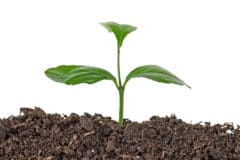Potting
Grow you indoor lemon tree (Citrus limon) in a lightweight plastic or polypropylene pot with several drainage holes in its base. Start with a 5-gallon, 12-inch pot.
Expect to repot to the next larger size every three to five years, or when you see roots escaping the drainage holes.
Potting Soil
Use a pre-moistened, well-draining commercial potting mix without fertilizer or chemical wetting agents. To make your own, mix equal parts of:
- Perlite
- Coarse sand
- Peat moss
Sunlight
Your indoor lemon tree needs eight or more hours of daily sun to flower and fruit. No sunroom or south-facing window? Consider supplementing your natural light with fluorescent ones.
Temperature and Humidity
Outdoor lemon trees flourish in the warm summers and mild winters of USDA hardiness zones 9 through 11. Indoors, aim for an average temperature of around 65°F (18.3°C). For the best performance, move your tree outside once the temperature is consistently above 55°F (12.8°C).
To help them cope with dry indoor air, mist the leaves with water once or twice a week.
Watering
Water enough to keep your trees roots consistently moist but never soggy. Depending on its size, 1 to 2 quarts of water every 5 or 7 days will be enough. It’s better, however, to err on the dry side.
For a DYI moisture tester, sharpen a ¼-inch wooden dowel and poke it into the soil at differing depths. Eventually you’ll know from the color, feel and odor of each soil sample if it’s time to water.
Expert gardener’s tip: Always empty the drainage saucer right away. Wet roots invite fungal disease.
Fertilizer
To prevent accumulated mineral salts from burning your tree’s roots, use slow-release, organic 6-3-3 fertilizer. Apply one enhanced with trace minerals, including calcium, zinc, iron and manganese, at the label’s recommended rate.
Pest Control
Growing your tree indoors doesn’t mean that aphids, whiteflies, mealybugs and other sap-draining insects can’t find it. Once you notice their sticky, clear waste on the leaves, locating the invaders won’t take long.
To eliminate them, spray the tree to runoff with organic insecticidal soap. Be sure to saturate the backs of the leaves. Spray every three days until the infestation ends.












